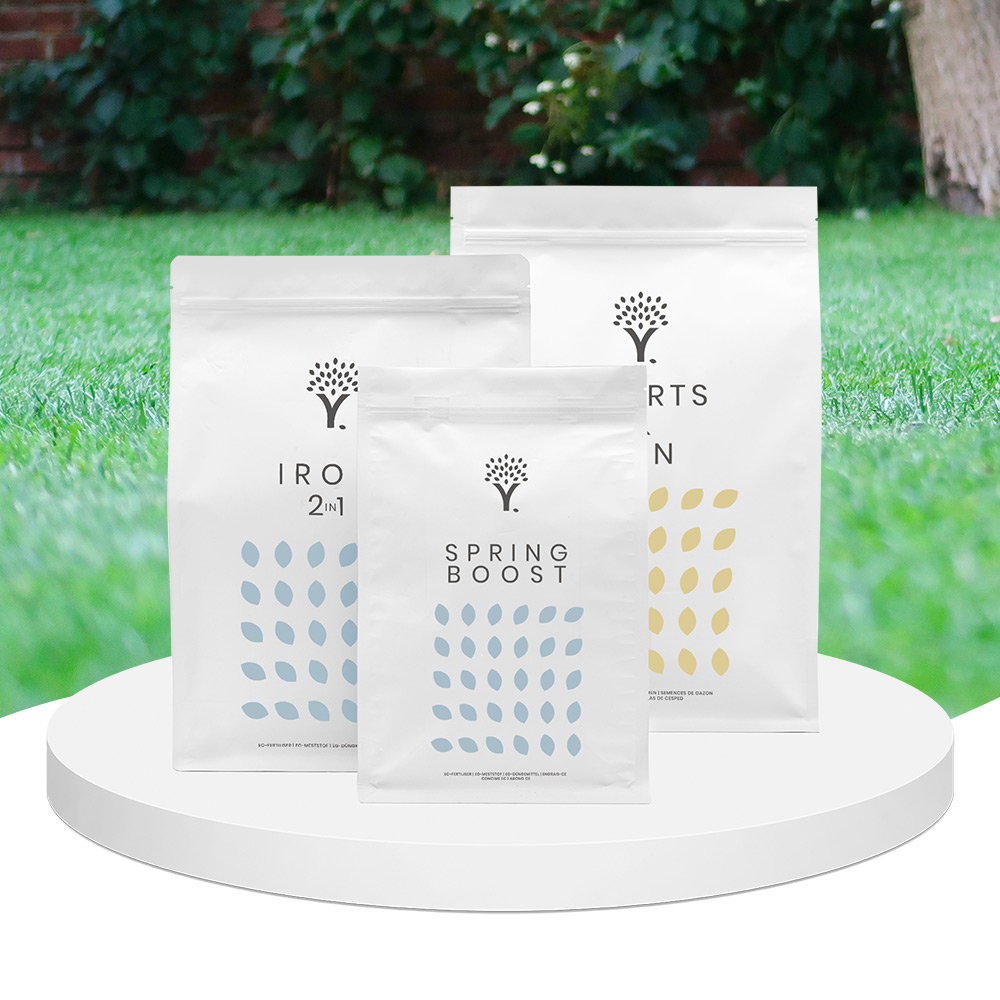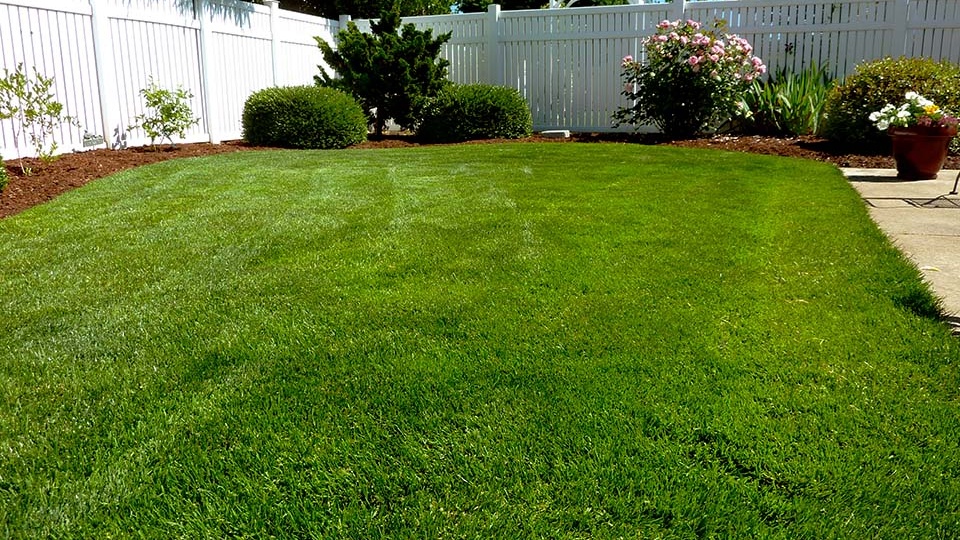Log in or create new account to save this product to your wishlist.
A Complete Guide to NPK fertilisers: what does it mean and what does it do?
NPK: what's that all about then? Most high-quality fertilisers provide an NPK number on the back of the packet. This article will help you determine which NPK fertiliser to use!
Latest articles
7 MIN 22 Jul How to keep your lawn in shape this summer 9 MIN 15 Jul Watering Your Garden: 10 Top Tips! 11 MIN 15 Jul Is Your Grass Type Right for your Garden? 11 MIN 10 Sep Create Your Low-Maintenance Garden – Tips and Ideas 11 MIN 08 Sep The Ultimate Guide to Choosing the Perfect Hedges for Your Garden 12 MIN 30 Aug The Top 20 Evergreen Climbers to Transform Your GardenBuying fertiliser should be easy, right? Well, it is – as long as you know what to look for. Because not all fertilisers are the same. Some are more suited to springtime than autumn; others help strengthen the roots, while others deepen the green colour. And what the heck is that NPK number all about?
- Why do we need to fertilise our lawns?
- What is fertiliser?
- What does NPK stand for?
- The Role of Each Nutrient
- Too little or too much NPK in your lawn? How to recognise it!
- Why the composition of fertiliser is so important
- Percentages and composition of NPK fertiliser
- Why doesn’t the NPK add up to 100?
- Secondary nutrients and trace elements
- FAQ
It’s a conundrum. But those three little numbers make everything clear.
This article is all about the NPK ratio you see printed on the back of your packet of fertiliser. You might have noticed it and wondered what it means.
Well, look no further – we’re going to guide you in the ways of the NPK number. And once you’ve mastered the NPK, you’ll become a qualified doctor of grass (well, not officially, but we can make you a certificate if you like).
With the right know-how, you’ll be able to diagnose your lawn problems and develop an NPK solution that helps it recover.
We’ll call you Dr Lawn from now on.
Why do we need to fertilise our lawns?

It might seem like a stupid question, but let’s start from the very beginning.
Your lawn needs water, light, and nutrients to survive and thrive. Of course, the rain (or your hosepipe) supplies the water, the sun provides the light, and – mostly – the soil supplies the nutrients.
But:
Soil has a finite nutrient resource. Of course, nature has a way of balancing itself out, and – when left entirely to nature – the cycle of organic decomposition helps maintain a perfect balance of nutrients within the soil.
However, our lawns aren’t really grown in “nature” – we disrupt the cycle of decomposition and growth by:
- Removing fallen organic matter (such as leaves in the autumn), and
- Mowing our grass for neatness
When we mow, we cut off the tips of the blade – but we also remove a valuable nutrient resource for our grass plants, which stores their sugars in their leaves.
So, each time we cut our lawns, our grass plants demand more nutrients from the soil because we’ve sliced off some of its valuable food sources.
And THAT is what eventually depletes the soil’s nutrient supplies (along with removing fallen organic matter).
And – over time – the nutrient balance loses its equilibrium, and the soil becomes exhausted.
Bad times.
What is fertiliser?

Fertiliser replaces lost nutrients to help bring balance back to the soil.
You can fertilise with organic matter, like mulch, leafmould, or homemade compost. But those compounds can be a little heavy for lawns – those are more suited to your flowerbeds.
Lawns need a specific nutrient balance, so using a specialist lawn fertiliser is essential.
These consist of a mineral mix of:
- Nitrogen (N),
- Phosphorus (P), and
- Potassium (K)
as their principal nutrients, along with a range of secondary nutrients to help your lawn get everything it needs.
So, a fertiliser you might use on your roses or rhododendrons isn’t going to supply the correct nutrient mix for your lawn.
What does NPK stand for?

All plants need carbon, hydrogen, and oxygen to grow and survive – these are supplied by the air. But grass plants also need:
- Nitrogen (N),
- Phosphorus (P)
- Potassium (K)
The letters N, P, and K refer to the chemical symbol on the Periodic Table – remember that from Chemistry lessons at school?
Each of those three elements benefit your lawn in different ways.
And those are:
The Role of Each Nutrient
N = Nitrogen: the function of nitrogen in your grass
Plants don’t grow without nitrogen, so you could consider N as the most crucial nutrient for your lawn.
Plants need nitrogen to photosynthesise (using sunlight to create food). Photosynthesis generates the deep green in plant leaves, so if you want a lawn with a beautiful deep green colour, it needs nitrogen.
Nitrogen moves quickly through the soil when applied as a fertiliser. This helps your grass grow more rapidly while stimulating root growth and boosting the cellular development of your grass plants.
A good nitrogen supply makes your turf stronger, making it more resilient to heavy use and disease.
But, your lawn only needs additional nitrogen during the peak growing season – in the spring and possibly during the autumn. If you have a newly seeded lawn, avoid giving it too much nitrogen – it’s better to let it develop its roots naturally at first.
Too much N can be bad for your lawn. If your lawn looks stressed (such as during drought), don’t add nitrogen because it will boost growth and exacerbate the plant’s stress.
P = Phosphorus: the function of phosphorus in your grass
Phosphorus might sound like a character from The Tempest, but it also has an essential role in lawn health: root development.
Phosphorus helps strengthen your lawn’s roots, making them more able to absorb other nutrients and water from the soil. This compound is essential for young lawns – whether from seed or turf.
Clay soils tend to hold onto their phosphorus, whereas sandy soils often have lower natural phosphorus levels. This is because the particles in clay soil have a larger surface area, which absorbs P more easily than the smaller, granular particles in sandy soil.
Use a soil tester to establish the P levels in your soil – measure this every two years, and replenish if the phosphorus is low.
K = Potassium: the function of potassium in your grass
Potassium increases your lawn’s resistance to drought, disease, and fungi. It strengthens the cell walls and ensures that water and carbohydrates circulate freely around the plant.
Like Nitrogen, potassium soaks into the soil quickly, but – likewise – it can be easily flushed out.
Potassium contains salt, which is essential for winter – ensuring that your grass can withstand freezing temperatures without cellular damage to the plant.
Grass consumes potassium more quickly than phosphorus, so regularly add extra K to the soil.
Too little or too much NPK in your lawn? How to recognise it!

Too much or too little of a good thing is always problematic. And the same can be said for the NPK levels in your lawn.
These are the tell-tale signs to look for:
Nitrogen
These states indicate low nitrogen levels:
- Yellow or brown grass blades
- Diseases and fungal infections, such as red thread
Red thread is a fungal infection where red “fungal needles” intertwine between your grass blades. It looks a little like the blades of the grass have turned red, but if you look closely, you’ll see that needle-like strands extend around the grass blade.
Red thread infection causes dead areas of grass, so this infection is best avoided – treated with nitrogen.
However, add too much nitrogen, and your grass will grow extremely fast – like weeds. So, unless you want to mow your lawn every single day, avoid adding too much nitrogen to your fertiliser mix.
Phosphorus
A lack of phosphorus can result in a buildup of carbohydrates and sugars, causing the emergence of reddish/purple anthocyanin pigments. So, too little P in your lawn soil makes the grass blades turn an odd shade of purple.
The plant’s roots will be shallow and weak, which means that your lawn will be more susceptible to infection from fungi and weeds.
Phosphorus deficiency can present in similar ways to nitrogen deficiency, with the added symptom of poor blade coverage, making the lawn seem a little bald.
Adding phosphorus will improve these conditions, but never add too much because it can cause poor ongoing growth (and could even kill your grass). Too much phosphorus reduces your grass’s ability to take up micronutrients – particularly zinc and iron.
Again, test your soil’s phosphorus levels using a soil tester kit or an electronic tester.
Potassium
A lack of potassium can be seen in the grass blades. They may appear to have developed yellow edges and brown spots, or even yellow or brown veins in broadleaf varieties.
The correct potassium level in the soil helps plants grow more quickly and make better use of water availability (with an improved drought response). It helps fend off diseases and resists pests.
However, too much potassium can harm the environment because it contains a lot of salt. So, be careful to add the right amount.
Why the composition of fertiliser is so important
Your grass needs different nutrients at different times of the year. So, it stands to reason that you feed your lawn according to its needs.
NPK for the spring

Your grass goes dormant over the winter months, waking up when the soil temperature reaches a good, consistent 10ºC. That’s usually around February/March, and this is the time to add nitrogen, helping your lawn recover and bounce back after winter.
MOOWY’s Spring Boost fertiliser offers 12% nitrogen, which is enough to give your grass plants the kickstart they need. This fertiliser mix contains phosphorus (5%) to help the roots recover and potassium (5%) for additional disease resistance.
If you look at the label, it says that Spring Boost contains an NPK ratio of 12-5-5. That means 12% nitrogen, 5% phosphorus, and 5% potassium.
However, Spring Boost also includes 2% Magnesium Oxide as a secondary nutrient, which stimulates the cell structure of your grass plants, improving photosynthesis.
NPK for the summer

Your grass grows at its fastest during the summer, so you don’t want to overstimulate it with high nitrogen levels at this time of year. Over-stimulation in the summer can actually weaken your lawn during the winter, making it more susceptible to disease.
So, use a lower-nitrogen fertiliser during the summer, like MOOWY’s All-Round Lawn Fertiliser, which has a:
- Nitrogen (N) level of 6%
- Phosphorus (P) level of 5%
- Potassium (K) level of 12%
The NPK ratio is 6-5-12, with a 2% Magnesium Oxide content.
NPK for the autumn

It’s good to add a fertiliser with a high phosphorus level in the autumn to help strengthen roots before the winter dormancy. And a high proportion of potassium helps develop your lawn’s resistance while it’s most vulnerable during the winter.
Our Lawn Starter fertiliser has an NPK mix of 6-10-8; that’s 6% Nitrogen, 10% Phosphorus, and 8% Potassium. It might be called Lawn Starter, but it also makes the perfect autumn fertiliser for established lawns.
Percentages and composition of NPK fertiliser
Always check the label of your fertiliser. Choose one according to your lawn’s needs and the time of year.
You’ll see this on our Spring Boost Fertiliser:
| N | P | K |
| 12 | 5 | 5 |
The numbers are percentages per 100g.
So, in this case, there’s 12g of nitrogen, 5g of phosphorus, and 5g of potassium.
Why doesn’t the NPK add up to 100?
If the NPK is a percentage, surely it should add up to 100? 12+5+5, for example, adds up to 23.
What’s in the other 77% of the fertiliser?
Well, the simple answer is: if you added pure chemicals to your lawn, it would scorch the leaves, burn your skin, and potentially poison the air.
NPK fertilisers are – by definition – a mix, and that mix needs to be held together with secondary nutrients and inert materials that help condition your soil and safely deliver the necessary chemicals.
MOOWY fertilisers are delivered in coated granules. The coating provides a slow release of the chemical compounds, which means that you can fertilise less often. Granules are generally considered better than powders which can blow away in the wind (and contaminate other soils in your garden, and potentially contaminate the air).
So, all fertilisers need a binding agent to make them safer to use and protect your grass plants.
Secondary nutrients and trace elements
NPK substances are considered the primary nutrients, but most fertilisers also include a range of secondary nutrients and trace elements.
Common secondary nutrients include:
- Calcium – helps strengthen the plant’s cell structure while reducing soil acidity.
- Magnesium – stimulates growth and boosts chlorophyll development.
- Sulfur – suitable for enzyme development, making the grass more resistant to the cold.
Trace elements include tiny amounts of metal minerals, such as iron, zinc, and boron.
Do you want to start now, or do you want more information?
We hope you’ve got a clear understanding the NPK ratio printed on your fertiliser label, but we’re always here to help if you have any other questions.
Get in touch, and we’ll be happy to help!
Happy fertilising!
FAQ
N=Nitrogen, P=Phosphorus, K= P=Potassium. The NPK number refers to the balance of those chemical elements.
Tomatoes need lots of everything to grow healthy fruit, but look for an NPK of 10-10-10 or 5-10-10.
It depends on the plants, but studies have identified that flowering plants enjoy an NPK of 3-1-2.
Leave a comment
Your answer will be displayed on the site and the interested party will be notified by email.
Leave a comment
Have a question or want to share your experience? Leave us a comment.
Read more
The best tips and tricks for a lush green lawn
 Scarifying Kit
All products after scarifying | Quickly restores the lawn after scarifying | Outsmart weeds quickly with the use of this kit
From: € 39.99
Scarifying Kit
All products after scarifying | Quickly restores the lawn after scarifying | Outsmart weeds quickly with the use of this kit
From: € 39.99
 Spring Lawn Care Kit
MOOWY’s choice for the spring | Quick recovery of your lawn after winter | A strong lawn prevents weeds
From: € 25.99
Spring Lawn Care Kit
MOOWY’s choice for the spring | Quick recovery of your lawn after winter | A strong lawn prevents weeds
From: € 25.99
 Long Lasting Lawn Fertiliser
Effective for 90 days | See results in 14 days! | Suitable for all types of grass and soil
From: € 13.99
Long Lasting Lawn Fertiliser
Effective for 90 days | See results in 14 days! | Suitable for all types of grass and soil
From: € 13.99
Do you want a lawn calendar?
🌱 All important maintenance moments for your lawn during the year. Leave your email and we will send you the lawn calendar for free.
Enter your email
Receive the lawn calendar in the mail
Enjoy a green lawn all year round!












Comments (0)
There are no comments yet. Well then, what are you waiting for to
Be the first to write your comment!inaugurate this pretty page?
Do you have some comments?